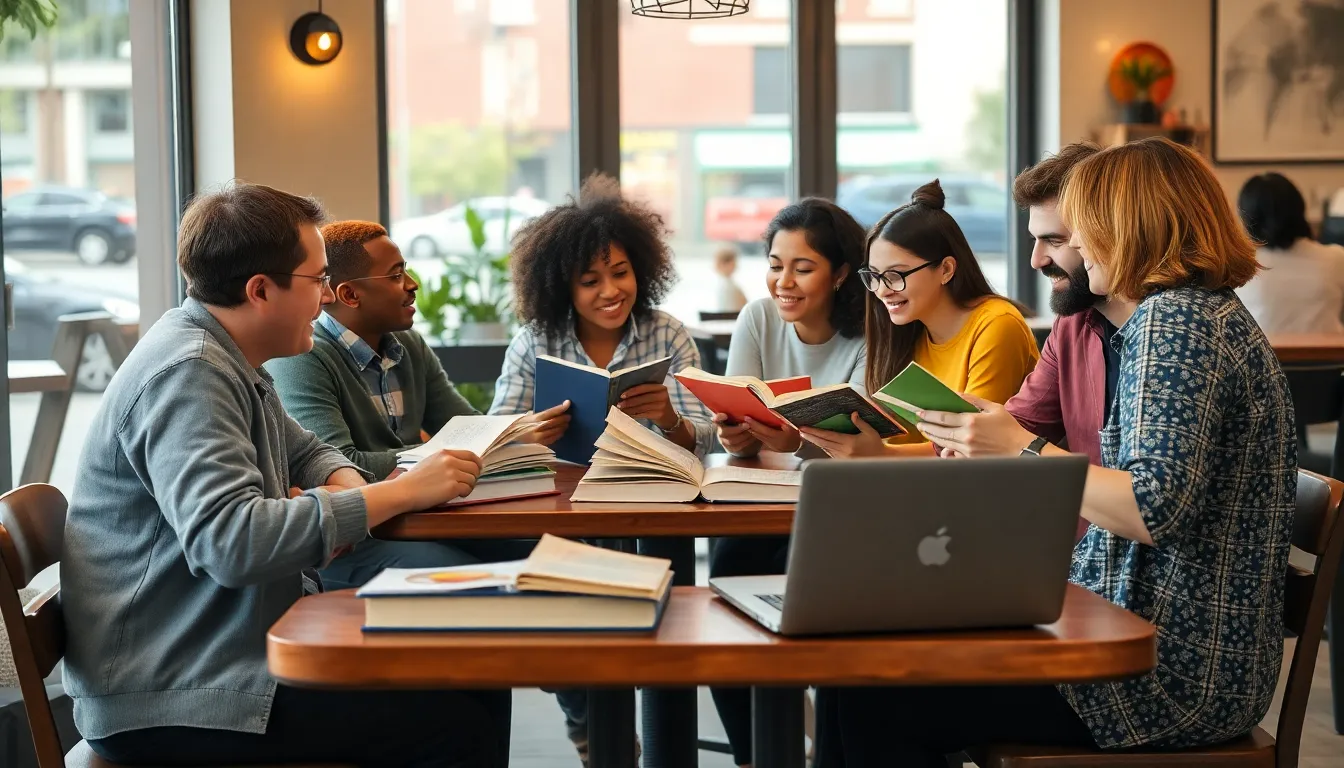In a world where language barriers can feel like climbing Mount Everest in flip-flops, a collaborative language community emerges as the trusty Sherpa guiding you to the summit. Imagine a vibrant space where learners and fluent speakers unite, sharing knowledge, tips, and the occasional meme about mispronounced words. It’s not just about mastering a new language; it’s about building connections, friendships, and maybe even a few inside jokes along the way.
Table of Contents
ToggleOverview of Collaborative Language Community
A collaborative language community serves as a crucial support system for those learning new languages. Members engage in various activities that encourage active participation. These could include language exchanges, discussion forums, and online meetups.
In this community, learners and fluent speakers collaborate to enhance their linguistic skills. Sharing resources like study materials, vocabulary lists, and pronunciation tips fosters a rich learning environment. Engaging in group conversations not only improves language fluency but also builds confidence.
Social aspects play an important role in these communities. Connecting with others creates friendships and helps members feel less isolated in their language journey. Humor and shared experiences often surface in discussions, making the learning process enjoyable.
Technology facilitates the growth of collaborative language communities. Platforms like social media, dedicated language apps, and online forums allow users to connect with diverse individuals. Such tools make language practice accessible and convenient.
Research shows that collaborative learning significantly boosts language acquisition. A study highlighted that peers often provide valuable feedback, which enhances understanding. Therefore, being part of a supportive community amplifies the benefits of individual study efforts.
Members contribute to the community’s success by actively participating in discussions and offering assistance. Regular interaction deepens connections and cultivates a sense of belonging. Engaging with others in a collaborative atmosphere transforms language learning into a collective, enriching experience.
Key Features of Collaborative Language Communities

Collaborative language communities embody essential characteristics that enhance the learning experience for language enthusiasts. Key features include inclusivity and diversity, alongside shared learning goals.
Inclusivity and Diversity
Inclusivity fosters an environment where individuals from various cultural backgrounds feel welcome. Diverse perspectives enrich discussions, allowing members to explore languages through unique lenses. Together, they celebrate different dialects and cultural nuances, enhancing understanding and appreciation. Access to varied resources helps learners find the support needed for their language journey. Communities often establish guidelines that promote respectful interaction, ensuring that all voices are heard and valued.
Shared Learning Goals
Shared learning goals drive members to pursue fluency collaboratively. Establishing collective objectives helps create a focused learning path. Members frequently engage in activities that align with these goals, such as group study sessions, workshops, and language challenges. Accountability emerges as peers encourage each other, motivating sustained progress. Feedback shared in these collaborative settings enhances individual learning outcomes. Collaborative projects often prompt learners to stretch their capabilities, making the process both fulfilling and effective.
Benefits of Collaborative Language Communities
Collaborative language communities offer numerous advantages, particularly for language learners. Members benefit significantly from shared experiences and collaborative opportunities.
Enhanced Language Proficiency
Learners improve their language skills rapidly through interaction with fluent speakers. Engaging in real conversations contextualizes vocabulary and grammar. Language exchanges foster practice in authentic settings, enabling learners to gain confidence. Additionally, receiving immediate feedback from peers enhances their understanding of nuanced language usage. Frequent participation in discussions provides exposure to various dialects, promoting overall proficiency. This dynamic learning environment nurtures development, making mastery of new languages achievable.
Cultural Exchange Opportunities
Cultural exchange flourishes within collaborative language communities. Diverse backgrounds enrich conversations, offering insights into different customs and traditions. Members share unique experiences, widening perspectives beyond linguistic boundaries. Exploring cultural contexts enhances language learning, as understanding local customs improves communication. Social events often highlight culinary practices, festivals, and cultural celebrations, fostering connections among members. By immersing themselves in varied cultural dialogues, learners develop greater empathy and awareness, essential skills for effective communication in their new language.
Challenges in Collaborative Language Communities
Collaborative language communities face several challenges that can hinder their effectiveness. Members often encounter obstacles that affect communication and group cohesion.
Communication Barriers
Language differences create significant hurdles in collaborative settings. Misunderstandings can easily arise, especially among participants with varying proficiency levels. Non-verbal cues may lead to confusion, and words can have different meanings depending on cultural context. Additionally, participants may struggle with using language-specific idioms and slang. Members need patience and a willingness to clarify meaning to overcome these barriers. Providing resources for language learning can bridge gaps, encouraging smoother conversations and fostering better understanding.
Group Dynamics and Conflict Resolution
Group dynamics often impact collaborative language communities. Varying personalities and learning styles can lead to friction among members. Some individuals may dominate discussions, which can discourage quieter participants from sharing their thoughts. Establishing clear guidelines for participation helps create an inclusive atmosphere. When conflicts arise, addressing them promptly ensures that group harmony remains intact. Encouraging open communication fosters trust and respect among members, allowing for effective conflict resolution. By focusing on collaborative goals, participants can work through disagreements and enhance their collective learning experience.
Examples of Successful Collaborative Language Communities
Duolingo’s user forums exemplify collaborative language communities by encouraging peer support. Members share tips, answer questions, and create a network of learners assisting one another. This interaction enhances language skills while fostering friendships among users.
Tandem provides an innovative platform for language exchange. Users connect with fluent speakers through text, voice, or video chats. Engaging in conversations allows participants to practice languages in real-time, building both confidence and proficiency.
ConversationExchange serves as another successful example. This website connects learners with local speakers for face-to-face language practice or online chats. Participants gain insights into cultural nuances, enriching their learning experience within a supportive environment.
Reddit hosts various language learning communities, such as r/languagelearning. This forum fosters discussion and provides resources for learners at different levels. Users can ask questions, share experiences, and find accountability partners, promoting collaboration among members.
Facebook groups, like “Language Exchange and Conversation Practice,” also thrive on connection. Members post language learning queries, and experienced users provide direct feedback. This informal setting encourages participation and fosters a sense of belonging among learners.
Meetup facilitates in-person language events worldwide. Local groups organize language meetups, where participants practice speaking in a social atmosphere. Real-life interactions enable deeper connections and the opportunity to apply language skills in various contexts.
Online platforms like Meetup and HelloTalk encourage cultural exchanges as well. Learners immerse themselves in diverse perspectives, enriching their understanding of languages. These platforms create opportunities for individuals from different backgrounds to collaborate while learning.
All these examples demonstrate the effectiveness of collaborative language communities in promoting language acquisition. Engaging with others transforms the learning process into a shared journey, emphasizing support, connection, and cultural exchange.
Collaborative language communities play a vital role in enhancing the language learning experience. By fostering connections among learners and fluent speakers, these communities create a supportive environment that encourages growth and understanding. The blend of humor shared experiences and cultural exchanges enriches the journey toward fluency.
Active participation not only boosts language skills but also cultivates friendships that can last a lifetime. As technology continues to evolve it opens doors for more diverse interactions and learning opportunities. Embracing inclusivity and collaboration helps overcome challenges and ensures that everyone feels valued in their language journey. Ultimately these communities transform language learning into a shared adventure filled with discovery and connection.






